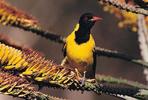
Appearance
This bird has a very liquid sounding call which is a common sound in the area. They are a striking yellow colour with a black head. Like the other orioles, it has bright yellow plumage with the difference being the distinctive black head, which makes it a conspicuous bird.
Although it has bright colours, it may still be difficult to spot, because its preferred habitat is among the foliage of high trees and thick bush. It is likely to be heard before being seen as its liquid whistles interspersed with lowish, drawn-out screeching sounds, are loud and draw attention.
The black-headed oriole has a slightly swooping, fast-and-direct flight pattern, which takes it on forages for the fruit and insects that it feeds on. Its long, strong bill is good at devouring most insects, with caterpillars, locusts and beetles all being fair game.

